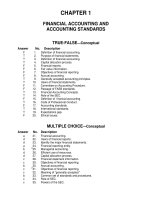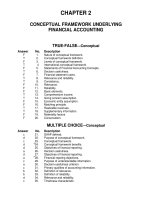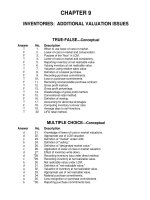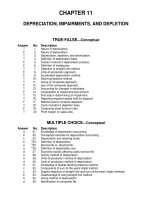Intermediate accounting 16e by kieso slide ch09
Bạn đang xem bản rút gọn của tài liệu. Xem và tải ngay bản đầy đủ của tài liệu tại đây (6.5 MB, 83 trang )
9-1
PREVIEW OF CHAPTER 9
Intermediate Accounting
16th Edition
Kieso ● Weygandt ● Warfield
9-2
9
Inventories: Additional Valuation Issues
LEARNING OBJECTIVES
After studying this chapter, you should be able to:
1
Understand and apply the lower-of-cost-or-net
4
realizable value rule.
2
3
9-3
Understand and apply the lower-of-cost-or-market rule.
Determine ending inventory by applying the gross profit
method.
5
Determine ending inventory by applying the retail
inventory method.
Understand other inventory valuation issues.
6
Explain how to report and analyze inventory.
LO 1
LOWER-OF-COST-OR-NET REALIZABLE VALUE
A company abandons the historical cost principle when the future utility (revenue-producing ability) of the
asset drops below its original cost.
Definition of Net Realizable Value
Net realizable value (NRV) is the estimated selling price in the ordinary course of business, less
reasonably predictable costs of completion, disposal, and transportation.
9-4
LO 1
Definition of Net Realizable Value
Illustration: Assume that Mander Corp. has unfinished inventory with a cost of $950, a sales value of $1,000,
estimated cost of completion of $50, and estimated selling costs of $200. Mander’s net realizable value is
computed as follows.
ILLUSTRATION 9-1
Computation of Net Realizable Value
9-5
LO 1
Definition of Net Realizable Value
ILLUSTRATION 9-1
Mander reports inventory on its balance sheet at $750.
In its income statement, Mander reports a Loss Due to Decline of Inventory to NRV of $200 ($950 −
$750).
ILLUSTRATION 9-2
LCNRV Disclosures
9-6
LO 1
Illustration of LCNRV
Regner Foods computes its inventory at LCNRV, as shown in Illustration 9-3 (amounts in
ILLUSTRATION 9-3
thousands).
9-7
Determining Final Inventory Value
LO 1
Methods of Applying LCNRV
ILLUSTRATION 9-4
Alternative Applications of LCNRV
Companies usually price inventory on an item-by-item basis.
9-8
LO 1
Recording NRV Instead of Cost
The following inventory data is for Ricardo Company.
Ending inventory (cost)
Ending inventory (at NRV)
Adjustment to LCNRV
Loss
LossMethod
Method
Loss Due to Decline in Inventory
$ 82,000
70,000
$ 12,000
12,000
Inventory
12,000
COGS
COGS
Method
Method
9-9
Cost of Goods Sold
12,000
Inventory
12,000
LO 1
Use of an Allowance
Instead of crediting the Inventory account for market adjustments, companies generally use an allowance account,
often referred to as Allowance to Reduce Inventory to NRV.
Using an allowance account under the loss method, Ricardo Company makes the following entry to record the
inventory write-down to NRV.
Loss Due to Decline of Inventory to NRV
Allowance to Reduce Inventory to NRV
ILLUSTRATION 9-7
Presentation of Inventory Using an
Allowance Account
9-10
12,000
12,000
Recording NRV Instead of Cost
Balance Sheet
9-11
LO 1
Recording NRV Instead of Cost
Income Statement
9-12
LO 1
Use of an Allowance—Multiple Periods
In general, accountants adjust the allowance account balance at the next year-end to agree with the discrepancy
between cost and the LCNRV at that balance sheet date.
ILLUSTRATION 9-8
Effect on Net Income of Reducing Inventory to NRV
9-13
9
Inventories: Additional Valuation Issues
LEARNING OBJECTIVES
After studying this chapter, you should be able to:
1
Understand and apply the lower-of-cost-or-net realizable
4
value rule.
2
Understand and apply the lower-of-cost-or-market
method.
5
9-14
Understand other inventory valuation issues.
Determine ending inventory by applying the retail
inventory method.
rule.
3
Determine ending inventory by applying the gross profit
6
Explain how to report and analyze inventory.
LO 2
LOWER-OF-COST-OR-MARKET
The use of the lower-of-cost-or-net realizable value method works well to measure the decline in value of a
company’s inventory for most companies.
The FASB decided to grant an exception to the LCNRV approach for companies that use the LIFO or retail
inventory methods.
Rather than comparing cost to net realizable value, under the alternative approach, companies
compare a “designated market value” of the inventory to cost.
9-15
The approach is commonly referred to as lower-of-cost-or-market (LCM).
LO 2
LOWER-OF-COST-OR-MARKET
This approach begins with replacement cost, then applies two additional limitations to value ending
inventory.
Net realizable value (ceiling) and
net realizable value less a normal profit margin (floor).
Net realizable value (NRV) is the estimated selling price in the ordinary course of business, less reasonably
predictable costs of completion and disposal.
A company values inventory at the lower-of-cost-or-market, with market limited to an amount that is not more than
net realizable value or less than net realizable value less a normal profit margin.
9-16
LO 2
LOWER-OF-COST-OR-MARKET
Illustration: Assume that Parker Corp. has unfinished inventory with a sales value of $1,000, estimated cost
of completion and disposal of $300, and a normal profit margin of 10 percent of sales. Parker determines the
following net realizable value.
ILLUSTRATION 9-9
Computation of Net Realizable Value
9-17
LO 2
LOWER-OF-COST-OR-MARKET
ILLUSTRATION 9-10
Inventory Valuation— Lower-of-Cost-or-Market
What is the rationale for the Ceiling and Floor
Ceiling
Ceiling == NRV
NRV
limitations?
Not
>
Replacement
Replacement
Cost
Cost
Cost
Cost
Market
Market
Not
<
Floor
Floor ==
9-18
GAAP
GAAP
NRV
NRV less
less Normal
Normal
LCM
LCM
Profit
Profit Margin
Margin
LO 2
LOWER-OF-COST-OR-MARKET
What is the rationale for the Ceiling and Floor limitations?
9-19
Ceiling – prevents overstatement of the value of obsolete, damaged, or shopworn inventories.
Floor – deters understatement of inventory and overstatement of the loss in the current period.
LO 2
How Lower-of-Cost-or-Market Works
ILLUSTRATION 9-12
Determining Final Inventory Value
$65,000
Regner makes the following entry (using the loss method) to record the decline in value.
Loss Due to Decline of Inventory to Market
65,000
Allowance to Reduce Inventory to Market
9-20
65,000
LO 2
Methods of Applying Lower-of-Cost-or-Market
ILLUSTRATION 9-13
Alternative Applications of Lower-of-Cost-or-Market
9-21
LO 2
WHAT DO THE NUMBERS MEAN?
WHAT’S YOUR PRINCIPLE
“PUT IT IN REVERSE”
The lower-of-cost-or-net-realizable value (market) rule is designed to provide timely information about the decline in the value of
inventory. When the value of inventory declines, income takes a hit in the period of the write-down. What happens in the periods after
the write-down? For some companies, gross margins and bottom lines get a boost when they sell inventory that had been written down
in a previous period. For example, as the table below shows, Vishay Intertechnology, Transwitch, and Cisco Systems reported
gains from selling inventory that had previously been written down. The table also evaluates how clearly these companies disclosed the
effects of the reversal of inventory write-downs. For Transwitch, the reversal of fortunes amounted to 23 percent of net income. The
problem is that the $600,000 credit had little to do with the company’s ongoing operations, and the company did not do a good job
disclosing the effect of the reversal on current-year profitability. Even when companies do disclose a reversal, it is sometimes hard to
determine the impact on income. For example, Intel disclosed that it had sold inventory that had been written down in prior periods but
did not specify how much reserved inventory was sold. Transparency of financial reporting should be a top priority.
9-22
(continued)
LO 2
WHAT DO THE NUMBERS MEAN?
WHAT’S YOUR PRINCIPLE
“PUT IT IN REVERSE”
With better disclosure of the reversals that boost profits in the current period, financial transparency would also get a boost.
Gain from Reversal
Disclosure
Company
Vishay Intertechnology
Not available
Poor—The semiconductor company did not mention the gain in its earnings
announcement. Two weeks later in an SEC filing, Vishay disclosed the gain on the
inventory that it had written down.
Transwitch
Poor—The company did not mention the gain in its earnings announcement. Three
$600,000
weeks later in an SEC filing, the company disclosed the gain on the inventory that it
had written down.
Good—The networking giant detailed in its earnings release and in SEC filings the
Cisco Systems
gains from selling inventory it had previously written off.
$525 million
Source: S. E. Ante, “The Secret Behind Those Profit Jumps,” BusinessWeek Online (December 8, 2003).
9-23
LO 2
LOWER-OF-COST-OR-MARKET
Evaluation of LCNRV and Lower-of-Cost-or-Market Rule
Conceptual deficiencies:
Expense recorded when loss in utility occurs. Profit on sale recognized at the point of sale.
Inventory valued at cost in one year and at market in the next year.
Net income in year of loss is lower. Net income in subsequent period may be higher than normal if expected
reductions in sales price do not materialize.
9-24
Application of these rules uses a “normal profit” in determining inventory values, which is a subjective measure.
LO 2
9
Inventories: Additional Valuation Issues
LEARNING OBJECTIVES
After studying this chapter, you should be able to:
1
Understand and apply the lower-of-cost-or-net realizable
4
value rule.
2
3
9-25
Understand and apply the lower-of-cost-or-market rule.
Determine ending inventory by applying the gross profit
method.
5
Determine ending inventory by applying the retail
inventory method.
Understand other inventory valuation issues.
6
Explain how to report and analyze inventory.
LO 3









